Creative Drawing Ideas to Inspire Young Artists


Intro
Drawing can be an exciting way for children to explore their imaginations. Not only is it an enjoyable pastime, but it promotes creativity and cognitive development. With crayons in hand and a blank sheet of paper, children can unlock their artistic skills and express their thoughts visually. Through various themes, such as nature, animals, characters, and more, this exploration allows children to engage meaningfully with their surroundings.
When children draw, they don't just create pictures; they dive into a world where the only limit is their imagination. Each stroke of the pencil or marker can tell a story, represent their ideas, or reflect their emotions. Understanding how to guide them through this process can deepen their engagement and support their learning. The following sections present an array of drawing ideas tailored for young artists, providing both inspiration and structure to nurture their creativity.
Creativity teaches the child how to express, plan, and execute their ideas. It’s like giving them the keys to a wardrobe full of infinite possibilities.
Creative Activities
Craft Ideas
Crafting activities can spark children’s creativity in unique ways. These ideas don’t require a lot of expensive materials or elaborate setups, making them accessible. Here are a few simple craft ideas:
- Nature Collages: Take a walk outside and gather leaves, flowers, or interesting stones. Once home, children can glue these items onto a piece of paper to create beautiful nature scenes.
- Animal Masks: Using paper plates, scissors, and color pencils, kids can design their favorite animal masks. They can then wear them for a fun role-play session.
- Character Creation: Encourage children to draw or color pictures of their favorite characters from books or cartoons. After that, they can invent stories about these characters.
Step-by-Step Guides
Including structured steps for crafting can help guide the young ones effortlessly through the process.
Example of making a Nature Collage:
- Gather materials from the outdoors, such as leaves and small flowers.
- Get a piece of thick paper or a cardboard base.
- Arrange collected items on the paper.
- Use glue to adhere each piece in place.
- Let it dry and enjoy the beautiful artwork.
Educational Value
Aside from just passing time, these creative drawing activities have significant educational perks. They help develop fine motor skills, enhance problem-solving abilities, and encourage articulating thoughts and feelings. Crafts also help children learn to focus, follow directions, and work through processes, all essential skills for their overall development.
Inspiration Sources
To encourage a broader imagination, consider using resources like:
These platforms provide diverse examples and ideas that can inspire children to create and learn.
Engaging kids in drawing builds a foundation for self-expression. Fostering their inner artists might just be one colorful crayon away.
Prelims to Creative Drawing
In the realm of childhood, drawing serves as a vital avenue for expression and exploration. Creative drawing is not just a fun activity; it's a window into a child's mind. It reflects their thoughts, emotions, and unique perspectives. This activity is foundational in nurturing a child's intellectual and emotional development. As they pick up colored pencils or paintbrushes, they are not only creating art but also working on life skills that will benefit them in myriad ways throughout their lives.
The Importance of Drawing in Child Development
Drawing plays a significant role in child development, influencing various facets of growth. From fine motor skills enhancement to cognitive processes, it’s much more than simply putting marks on paper. Here are some key points illustrating the significance of drawing:
- Fine Motor Skills: When children draw, they practice hand-eye coordination. This leads to better control of their fingers and hands, which is essential for tasks like writing and self-care.
- Emotional Expression: Art allows children to express their feelings in a non-verbal way. Sometimes words aren't enough, and through colors and lines, they can convey what's in their hearts.
- Problem Solving: Every time a child approaches a blank canvas, they face choices on colors, shapes, and compositions. This decision-making fosters their ability to solve problems creatively, a skill that proves invaluable in all areas of life.
- Cognitive Development: Engaging in drawing can stimulate brain function, encouraging children to think critically and independently. It enhances their abilities to visualize concepts and understand spatial relationships.
- Cultural Awareness: Drawing can often reflect cultural elements, allowing kids to explore stories and symbols from various backgrounds, promoting diversity appreciation from an early age.
"Drawing is like a glimpse into a child's soul, where colors and shapes reveal their inner world."
How Drawing Encourages Creativity
Drawing is a powerful catalyst for creativity. It allows youngsters to think outside the box and explore uncharted territories of their imagination. Here are a few aspects in which drawing significantly boosts a child's creative faculties:
- Encouragement to Experiment: When children create, they learn that there are no right or wrong ways to express themselves. This freedom encourages them to explore new ideas, materials, and techniques without fear of failure.
- Innovation in Thought: As children draw, they often create fantastical worlds or unusual creatures. This imaginative thinking can be applied in various scenarios beyond art—technology, science, and literature can all benefit from innovative approaches.
- Storytelling Skills: Illustrations often accompany stories in children's minds. Through drawing, kids learn to narrate experiences and share their personal stories, developing narrative skills that are key in both communication and literacy.
- Visual Learning: Those who engage in drawing embody a different form of understanding. They learn to interpret information visually, a skill that's becoming increasingly relevant in our image-driven society.
- Increased Confidence: Completing a drawing can instill a sense of accomplishment, nurturing self-esteem. When children are proud of what they've created, they're more likely to take on challenges in other aspects of their lives.
In summary, creative drawing is much more than just an educational pastime. It is a multifaceted tool that supports key developmental milestones while enabling children to express their individuality. As future generations navigate through life, the importance of creativity and self-expression cannot be overstated.
Exploring Nature Through Art
The natural world is a treasure trove of inspiration for young artists. Exploring nature through art not only sparks creativity but also instills a sense of appreciation for the environment among children. Art allows children to observe, interpret, and express their understanding of the world around them. This section dives into how various aspects of nature can be represented in art, enriching children’s ability to convey experiences and emotions through their creations.
By engaging with elements of nature, children develop skills such as observation, critical thinking, and self-expression. Each brushstroke or pencil sketch becomes a window into their thoughts and feelings. Encouraging children to draw what they see encourages them to look closely and appreciate details, be it a flower’s petal or the clouds in the sky.
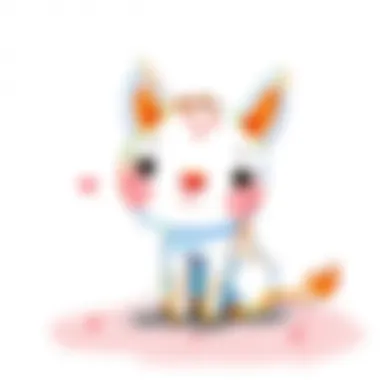
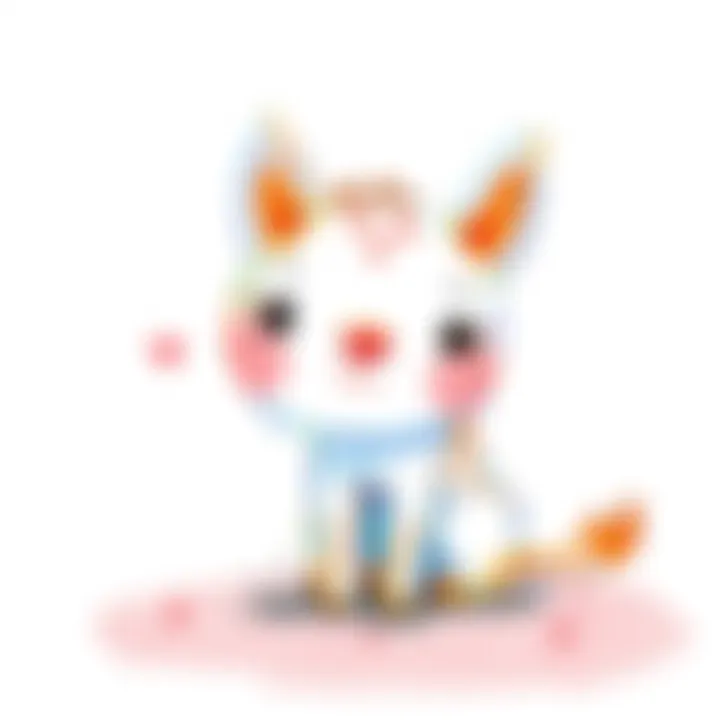
Landscapes and Sceneries
Landscapes serve as a broad canvas for children to explore their surroundings. Drawing landscapes can include mountains, rivers, or majestic forests, showcasing the beauty of the earth. Such endeavors provide a platform to discuss geographical features while letting imagination take flight. Children can take their art outdoors, sketching real-life landscapes or use photos as references. It encourages them to observe color gradients, shadow play, and the interplay of light and texture.
"Today’s art is tomorrow’s vision."
Here are some ways children can approach landscape drawing:
- Use natural materials: Pencils, crayons, or pastels mimic the textures found in nature.
- Capture feelings: Ask them to think about how certain places make them feel, allowing emotions to guide their art.
- Experiment with styles: Mixing realism with abstract can lead to unique interpretations of a landscape.
Flora and Fauna Sketches
Plant and animal subjects invite children to notice the diverse forms of life. Flora and fauna sketches provide a good mix of observation and creativity. Think of drawing daisies alongside bunnies, or perhaps butterflies fluttering around a garden. Children can draw from real life or their imaginations, aiming to depict vibrant colors or intricate patterns found in nature.
To incorporate flora and fauna into drawing sessions, consider these tips:
- Nature walks: Get outside and encourage children to draw what they spot in gardens, parks, or forests. It becomes a fun scavenger hunt for shapes and colors.
- Scientific illustration: Discuss the anatomy of plants and animals, encouraging children to include details like the veins in leaves or textures of fur.
Seasonal Changes in Art
Seasons bring a wealth of colors and moods. Drawing seasonal changes allows children to showcase transformations in nature. Spring blossoms, summer greenery, autumn leaves, and winter snowscapes each tell a different story. By focusing on seasons, children learn how the world evolves throughout the year.
Here are some ways to explore seasonal art:
- Color palettes: Discuss the colors associated with each season, helping kids to choose their crayons or paints accordingly.
- Theme projects: Assign a project like “A Day in Winter” to spur ideas that can be translated into a drawing.
Exploring nature through art bears fruits beyond the canvas. It cultivates patience, encourages observation, and enhances emotional intelligence as children express their thoughts and feelings related to the natural world.
Animal Inspirations for Drawing
Drawing animals can be a profoundly enriching experience for children. Not only do animals spark joy and curiosity, but they also help young artists learn about the world around them. Engaging with the beauty of the animal kingdom allows children to develop their observational skills, making it easier for them to notice details, develop shapes, textures, and even colors while sketching. Beyond the technical skills gained, fostering a creative outlet through drawing can be beneficial for emotional expression—providing a way for children to communicate their feelings and thoughts in ways that words sometimes can’t.
Wildlife Wonders
Wildlife is a treasure trove of inspiration, filled with diverse species that can ignite a child’s imagination. Encouraging kids to draw animals like lions, elephants, or even the intricate patterns of a peacock can impart a sense of wonder about the natural world. As children observe the unique characteristics of different animals, they begin to understand form, posture, and movement—essential elements in drawing.
- Explore Local Wildlife: A visit to a local zoo, nature reserve, or wildlife sanctuary can provide visual reference and live interaction with animals that would inspire drawing.
- Workshops and Classes: Look for community classes that offer guided drawing sessions focused on wildlife to help kids gain confidence in their artistic abilities.
- Field Guides: Providing children with field guides of nearby flora and fauna can help them appreciate the diversity of life around them, often sparking their interest in creating art.
Drawing wildlife can lead not just to artistic expression but also to conversations about conservation and the importance of protecting these creatures.
Pets and Their Personalities
Pets play a huge role in many families and serve as a wonderful avenue for children to explore drawing. Every pet has its own quirks and personality traits, which can be reflected in their artwork. Whether it’s the sleepy cat, excitable dog, or even a curious hamster, capturing these personalities can be both fun and rewarding.
Children can:
- Draw from Life or Photos: Encourage kids to sit next to their pet and sketch while observing, or use photos as references.
- Character Characteristics: Discuss what makes their pets unique, like a dog’s wagging tail or a cat’s playful antics, and encourage kids to highlight these features in their drawings.
- Create Stories: Help children create a story around their drawing, merging art with storytelling which enhances creativity.
The beauty of pets lies not just in their appearances, but also in the bonds they form with children, adding emotion and context to their artwork.
Imaginary Creatures
Letting young artists create imaginary creatures can be one of the most freeing drawing exercises. This not only boosts their creativity but also allows children to blend knowledge of animals with their whimsical ideas. Think about a creature that has the wings of a butterfly and the body of a lion; how fantastic is that?
- Promote Idea Generation: Provide prompts like, "What if your pet was an animal from another planet?'' This will help them think outside the box.
- Use Mixed Media: Encourage kids to combine different materials such as colored pencils, markers, and even glitter to create a mixed-media piece that reflects their imaginary being.
- Group Activities: Organize drawing challenges in schools or art clubs where kids can share and discuss their creations. This enhances collaboration and can lead to new friendships.
Imaginary creatures can reflect a child’s interests, fears, or dreams, which can be especially therapeutic for them.
Drawing animals, whether real or imaginary, allows children to express their thoughts and emotions while honing skills that are fundamental to their growth.
As we explore these different sources of inspiration, each drawing experience not only fosters creativity but also builds a deeper understanding and respect for the world around us, paving the way for more extensive learning and emotional development.
Character Drawing Ideas
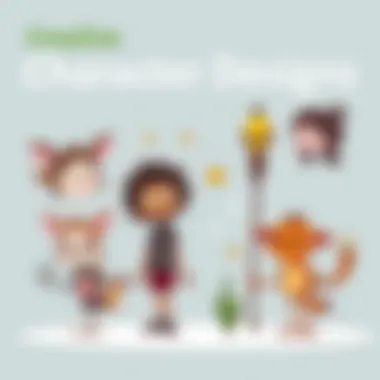
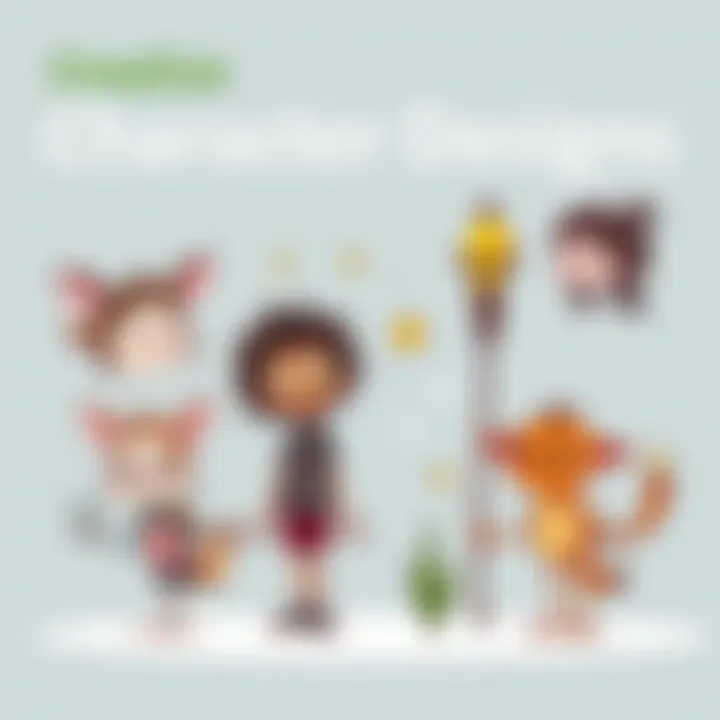
Character drawing is a fantastic way for children to express their creativity and develop a unique voice in their artwork. By exploring different characters through drawing, children can engage with their imagination, connect with storylines, and bring their ideas to life on paper. This section covers various aspects of character drawing that will help young artists sculpt their artistic identities while honing their skills.
Cartoon Characters
Cartoon characters are often the first point of inspiration for many young artists. They're colorful, exaggerated, and full of personality. When kids dive into drawing cartoon characters, they can learn about the fundamental elements of design, like shape and expression.
- Encouraging Imagination: Kids can create their own characters or redraw family favorites like Mickey Mouse or SpongeBob SquarePants. They can explore different styles and facial expressions, helping them to visualize emotions and moods.
- Learning Anatomic Simplicity: Unlike realistic portraits, cartoon characters are generally simplified, making it easier for kids to understand the basics of proportion and balance. They can experiment with body shapes and exaggerate features to see how these changes affect the character’s personality.
"Drawing cartoon characters allows children to break the constraints of realism, stimulating their imagination and creative potential!"
- Story Development: As they draw, kids can create backstories for their characters. This not only enhances their narrative skills but also encourages them to think critically about character development, motivations, and conflicts.
Superheroes and Villains
Children often admire superheroes and villains in movies and comic books. By drawing these characters, young artists can explore themes of good versus evil, identity, and power. This realm of character drawing opens up several avenues for creative thinking:
- Empowerment through Creativity: Identifying with a superhero can instill a sense of empowerment in children. They can design their own superhero, complete with unique superpowers and gadgets, which allows for an exploration of identity and self-esteem.
- Conflict and Resolution: By introducing villains into their artwork, children can learn about narrative structure. They may play with the idea of conflicts, challenges, and resolutions within their drawings. This not only makes drawing fun but also teaches important life lessons.
- Character Contrast: The juxtaposition of heroes and villains encourages understanding character traits. Children can analyze what makes someone a hero or a villain and how those traits translate visually. They can experiment with colors, shapes, and symbols to define their character’s essence.
Historical Figures and Legends
Drawing historical figures and legends is an enriching experience that combines art with learning. It allows children to connect with history in a hands-on way, deepening their understanding of the world:
- Cultural Exposure: Kids can research famous figures such as Cleopatra or Albert Einstein and illustrate them. This encourages an appreciation for history and diverse cultures.
- Artistic Interpretation: As they draw these figures, they have the freedom to interpret their clothing, environment, and even expressions. Through this, they can engage in discussions about the significance and impact of these figures on society.
- Legendary Stories: Drawing characters from myths or legends, like Hercules or Robin Hood, allows children to explore timeless themes. They can create scenes that depict battles, quests, or heroic acts, thereby igniting their imagination and fostering a sense of adventure.
Overall, character drawing serves as a powerful tool for self-expression, creativity, and learning. Through these diverse topics, children are not just sketching but weaving their narratives and expanding their understanding of the world around them.
Objects and Everyday Life
Objects that fill our daily lives don’t just serve practical purposes; they hold stories, memories, and endless possibilities for creativity. This section delves into how everyday items can become the subjects of drawing, offering children a chance to explore their imagination in familiar contexts. By encouraging young artists to draw objects found around them, we can enhance their observation skills, inspire creativity, and spark discussions about the world they inhabit.
Drawing familiar objects can help kids see the beauty in the ordinary. Each item, whether a simple spoon or their favorite toy, has unique shapes, colors, and textures that can inspire artistic expression. Furthermore, these drawings provide an opportunity for discussions about functionality and artistry, letting children understand how art can infuse meaning into everyday life.
Household Items as Artistic Subjects
Household items are often overlooked, yet they can serve as vibrant sources of inspiration. Items like a bright red kettle or a plush teddy bear can ignite a child’s creativity. For example, ask a child to sketch their favorite mug.
- Texture and Detail: Children can experiment with drawing textures, like the smoothness of the mug or the stitching on their teddy bear. They’ll learn to pay attention to details, enhancing their fine motor skills.
- Color Exploration: A simple request like, "What colors do you see?" can lead to a vibrant artwork showcasing their choice of hues.
Art activities can take it a step further by encouraging storytelling. A child might draw a scene involving their favorite household item—like a kitten drinking from a colorful bowl—transforming a simple sketch into a rich narrative.
Transportation Vehicles
From buzzing bicycles to massive trucks, vehicles encapsulate movement and energy. Drawing transportation offers a chance for children to explore shapes, forms, and the physics of motion.
- Types of Vehicles: Encourage kids to draw various modes of transport, including cars, trains, airplanes, and boats. Each presents unique challenges and styles of representation.
- Dynamic Action: Ask children to illustrate a vehicle in motion, perhaps a skateboard flying down a ramp. This can lead to discussions about speed and perspective in art.
Creating a scene where different vehicles interact—like a busy city street—can boost their imaginative skills while nurturing collaboration if they work together.
Food and Desserts
Food is a universal theme, rich with colors, shapes, and textures. Sketching food items is not only fun; it can be a platform for learning about nutrition and cultures.
- Variety and Color: Encourage kids to draw a plate full of various foods. Fruits, vegetables, and sweets can be juxtaposed to show contrasts in color and shape.
- Themed Drawings: Children might enjoy drawing their favorite dessert, such as a towering chocolate cake. Discussing the components and how they come together can inspire creativity and even conversations about cooking.
Through food illustrations, young artists can share familial ties and experiences, like drawing the pizza they had at a family game night. This not only anchors their artwork in personal history but nurtures pride in their creations as well.
By drawing objects from their everyday lives, children can bridge the gap between reality and imagination. This art practice empowers them to find beauty in the mundane, fostering a richer understanding of their surroundings.
Abstract and Imaginative Drawing Concepts
Drawing is not just about replication; it allows children to express feelings, thoughts, and ideas in ways that are uniquely their own. When we venture into abstract and imaginative concepts, we create a liberating space for young artists to transcend traditional boundaries. The beauty of abstract drawing lies in its boundless nature, where there’s no right or wrong. This approach not only cultivates creativity but fuels critical thinking and emotional intelligence.
Abstract art encourages children to explore various shapes and forms, pushing them to break the mold of realistic representation. They learn to observe their surroundings and see beauty in everyday life, transforming simple concepts into something extraordinary. Moreover, engaging in imaginative drawing helps improve fine motor skills and hand-eye coordination, essential components for their overall development.
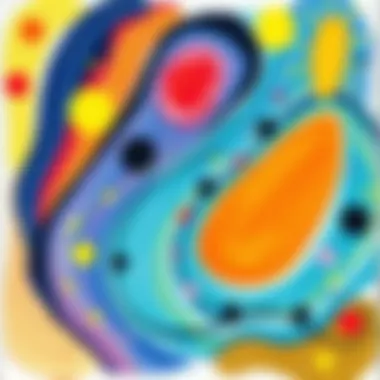
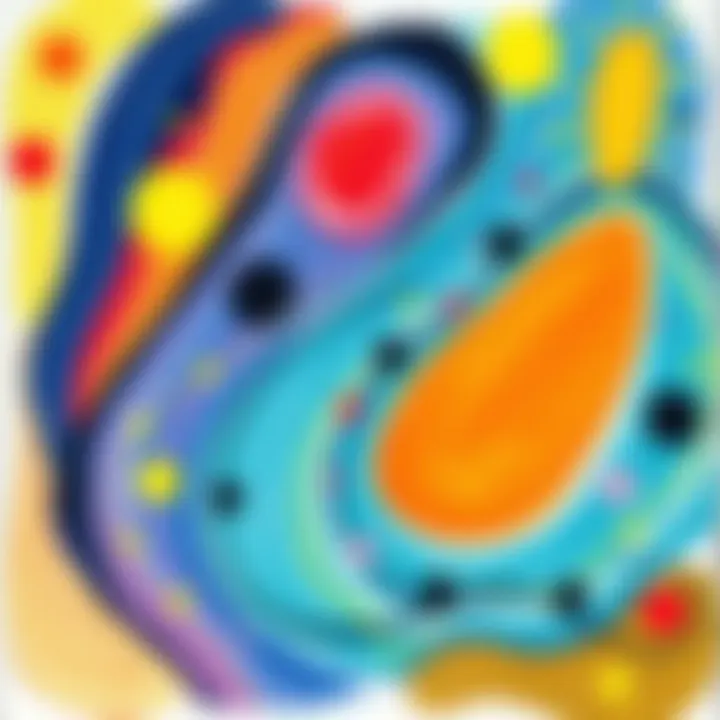
Shapes and Patterns
Shapes and patterns invite children to explore geometric forms and repetitive designs in their drawings. Kids might think of shapes as mere components, but these can be combined into fascinating artworks that tell a story or convey emotion. For younger ones, prompts like "Draw a house using only triangles and squares" can stir creativity and get the juices flowing.
In more intricate projects, consider introducing concepts like tessellation—where shapes fit together without any gaps. This could lead to hours of exploration and play. Encourage little ones to look around them; the world is filled with patterns, from tiled floors to leaves on trees. By observing and replicating these patterns, children can find inspiration in the mundane.
"Creativity is intelligence having fun."
— Albert Einstein
Color Exploration and Feelings
Color serves as a powerful tool in art, often speaking where words may fail. Children can explore how colors influence mood and convey emotions through their drawings. It’s fascinating, for instance, how a child might choose bright colors for joyous events but darker tones when feeling sad. To dig deeper, ask them to paint what happiness looks like or to illustrate a rainy day using cool shades.
Engaging in such activities allows them to connect their emotions with artistic expression. You could even introduce color theory in a fun way. For example, challenge them to create a rainbow using colors in a specific order or mix two colors to discover a new one. Such experiences can provide a rich ground for exploring feelings and emotions through art.
Dreamscapes and Fantasies
The world of dreams harbors limitless opportunities for creativity. Encouraging children to depict their wild imaginations can boost confidence in their artistic abilities. They might illustrate a dragon soaring over a candy-coated mountain or a magical forest filled with glittering creatures. Prompt them with ideas like, "What would your dream house look like?" or "If you could invent an animal, what would it be?"
These imaginative exercises help children break free from conventional thought and explore fantastical realms. It nurtures storytelling through drawings, weaving narratives into their art. Additionally, creating dreamscapes fueling imagination can spark conversations about their aspirations and hopes, reinforcing their connection with both their art and the world around them.
Tips for Encouraging Young Artists
Encouraging young artists is not merely about providing them with art supplies or a blank canvas; it encompasses creating an environment that nurtures imagination, fosters growth, and instills confidence. In this section, we delve into the pivotal elements that help children flourish creatively, ensuring they not only enjoy the process of drawing but also develop essential skills along the way.
Creating a Supportive Environment
A supportive environment can spell the difference between a child simply doodling and one who is fully engaged in artistic expression. When young artists feel safe to explore, they are more likely to take risks with their art.
- Space to Create: Designate a specific area in your home as their creative corner. This doesn't have to be extravagant — just a sturdy table and some storage for supplies will do. A place that contains their materials encourages them to create more often.
- Encouragement to Experiment: Let them know that there are no mistakes in art. If a child spills paint or goes outside the lines, consider it an opportunity for creativity, not a setback. Remind them that many famous artists started with a mess.
- Showcase Their Work: Consider hanging their drawings on the fridge or creating a mini-gallery at home. This public display lets them feel pride in their creations, reinforcing their love for drawing.
Creating this environment will not only enhance their drawing skills but also develop their confidence and sense of self-worth.
Offering Constructive Feedback
When it comes to young artists, feedback plays a crucial role. It can guide their development while also fostering a positive relationship with art itself. Here are some tips for providing constructive feedback:
- Be Specific: Instead of saying, "That's nice," focus on specific aspects. For example, "I really like how you used different colors in your drawing — it makes it look lively."
- Encourage Storytelling: Ask them what their artwork represents. This promotes deeper thinking about their intentions and can help with both their artistic and verbal skills.
- Balance Praise and Suggestions: Acknowledging what they did well, while gently offering suggestions for improvement, helps them see the value in their work without feeling criticized.
Ultimately, constructive feedback helps children refine their skills while maintaining their passion for art.
The Role of Technology in Modern Drawing
Technology now plays a significant role in the artistic realm, opening up new avenues for creativity. While traditional methods remain vital, incorporating technology can enhance the drawing experience.
- Digital Tools and Apps: Applications like Procreate and Adobe Fresco give young artists access to a plethora of brushes, colors, and even animation techniques. These tools make it easier for children to experiment with their artistry.
- Online Tutorials: Numerous resources exist online that provide step-by-step guides tailored for children. Websites like YouTube and educational platforms help artists of all levels learn new skills at their own pace.
- Virtual Art Communities: Platforms like DeviantArt and ArtStation allow young artists to share their work, receive feedback, and even collaborate with peers. This can greatly broaden their horizons and inspire new ideas.
While technology is a valuable asset in the drawing world, it’s crucial that it complements rather than replaces traditional methods. Balancing both can empower young artists to make the most out of their creative journey.
Finale: The Endless Journey of Creativity
In concluding our exploration of creative drawing ideas for children, we emphasize the significance of recognizing creativity as a lifelong journey. This topic serves as a reminder that creativity is not confined to a single moment or event; rather, it is a continuous process that can blossom through different stages of growth and development.
Engaging in drawing is critical for children, providing not just a form of expression but also aiding in their cognitive skills. Children discover their thoughts and feelings through line and color, which can be a profound and necessary outlet. As they tussle with concepts of space, texture, and perspective, they simultaneously hone their problem-solving skills. Moreover, creative drawing helps develop perseverance. When a child revisits their artwork, they learn to appreciate improvement and the nuances of their artistic journey.
With every pencil stroke, they spiral into a loop that intertwines skill with imagination. This act of creating fosters resilience, an essential quality that veers beyond the art world and touches various life practices.
"Art is not what you see, but what you make others see." - Edgar Degas
Reflection on Artistic Growth
Looking back on artistic growth involves more than just examining drawings—it's about understanding the trajectories of our young artists. Each piece created by a child reflects their inner world, showcasing development in their abilities and thought processes. It's essential for caregivers and educators to acknowledge not just the final product but the growth seen in sketches and paintings over time.
As children adapt their drawings to reflect new ideas, we notice progress in their ability to conceptualize and express their understanding of the world. A simple character evolving into a more detailed design embodies a child's emerging self-confidence and newly acquired skills. This self-awareness is crucial in helping them enjoy the journey instead of just focusing on the outcome.
Future Prospects in Artistic Training
As we look ahead, the potential for artistic training is vast. The integration of technology and modern techniques also offers a timely advantage to young artists who navigate a digitally influenced world. This aspect of art is not just about being adept with new tools; it encourages exploration and adaptation.
Parents and educators should contemplate incorporating various forms of artistic expression, from traditional mediums like pencil and paint to digital platforms that permit children to experiment freely. Workshops and community art classes can provide invaluable experiences that expand their creative horizons. Emphasizing a blend of skill-building exercises and free-form art making nourishes imagination and fuels a child's desire to create.
Art kits can be another useful method to spark interest, providing artists with all they need at their fingertips. These kits can range from classical supplies, such as colored pencils and charcoal, to digital tools and software that inspire innovation.







